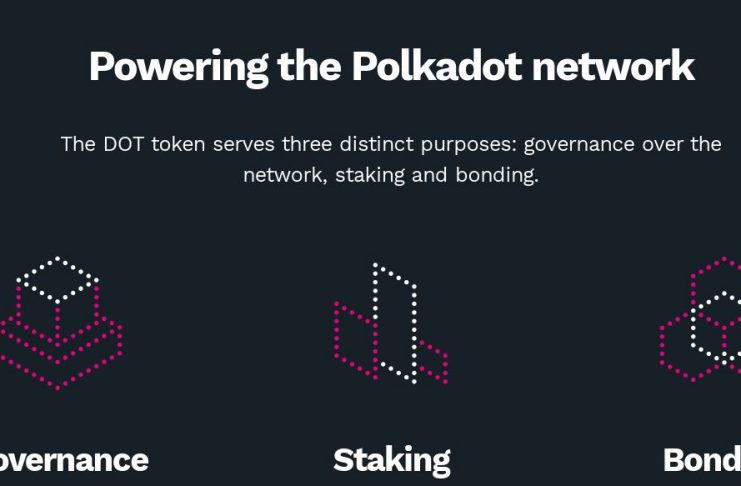IoT development is impossible without creating a decentralized environment. Linking devices to remote servers of IT companies is the initial, not the last stage in the evolution of the Internet of Things.
With the growing number of devices, the centralized model shows its weaknesses: insufficient bandwidth and vulnerability of data passing through the servers. The answer should be to build a multi-agent system, each participant of which is endowed with greater autonomy and is able to perform a wider range of tasks. We are talking, about the ability of a device to independently accept orders and pay for their execution, as well as to enter into a contract with another device without human mediation.
Ethereum smart contracts make it possible to implement such a concept, but only to certain limits – due to limited bandwidth, high cost of transactions, and the lack of a common language with other blockchains-unless the developers have come up with a special bridge for a specific case.
Polkadot, the flagship project of Parity Technologies and the Web3 Foundation, a sharding protocol that allows inter-blockchain communication, has a better chance to implement the idea of Web 3.0 and open the possibility of connecting millions of smart devices to the global network. Below we will analyze the reasons why the IoT sphere has become one of the main beneficiaries of inter-network protocols and consider the most promising IoT projects on Polkadot.
The update of the Ethereum 2.0 network, launched in the zero phase at the end of 2020, should open a number of functions due to the Proof-of-Stake consensus, and in the future, when moving to the next phases, it would deploy an experimental model known as sharding. In fact, it will be 65 new blockchains: the existing one from the zero phase of the Beacon Chain and 64 new shards interacting with it. The deployment of smart contracts and economic activities are planned for the those phases.
However, Ethereum 2.0 is not the first project that tries to apply the sharding model to enable inter-blockchain communication. Polkadot – the flagship project of Parity Technologies and the Web3 Foundation-was ahead of Ethereum in implementing the idea of Web 3.0 and the ability to connect millions of smart devices to the global network.
Why All Talks About Polkadot?
Six months after the launch of the Polkadot blockchain, the network clearly become recognizable in cryptocurrencies. According to Coingecko, at the time of preparation of this article, DOT holds the seventh position in market capitalization at its market cap is worth 6.58 billion dollars.
This market reaction is explained by the widespread demand for the inter-blockchain protocol on the part of developers of decentralized applications, primarily in the field of DeFi. The product of the Web3 Foundation’s three-year work solves the problems of bandwidth and scaling by being able to combine different blockchains.
The Polkadot protocol is based on sharding, i.e. dividing the network into segments with separate nodes-transaction validators. Unlike Ethereum, where each node calculates each operation and processes each transaction, the sharding model divides tasks between nodes, allowing multiple transactions to be validated in parallel. This greatly increases the speed of transaction processing.
According to the Polkadot project, the number of projects deployed on the Polkadot network is approaching three hundred, which is three times more than at the beginning of September 2020. The field of IoT on Polkadot is not yet exploited by the main media, so we decided to conduct a small study of DOT in the area of IoT.
Why Devices Are Still Not Smart
Unlike the DeFi segment with its 21 considerable projects, the IoT section offers only three projects-Node IoT, MHC, and Robonomics. There is a notable similarity between them.
MHS states its goal is to build a global network for the communication of IoT devices. MXC (Machine Exchange Coin) is a protocol that enhances LPWAN (low-power wide-area network) technology – an energy-efficient network. Simply put, wireless data transfer technology between sensors and counters. The project offers a system of smart bidding for the right to access sensors to the network, as well as a data market that combines various blockchains.
Like two other projects in this niche, MXC declares the goal of creating a decentralized environment for many smart devices. The number of such devices today is measured in billions. However, the fact that a scooter or vacuum cleaner is equipped with sensors and microprocessors does not make them smart. In order to be such, they need a constant Internet connection to receive and transmit data, as well as the ability to interact with other systems.
IoT Operations
Providing constant online access to millions of devices and sensors is not cheap, and the most difficult. The second, more important issue is security. Devices can be hacked and become dangerous, For example, a smart kettle can be turned on when there is no water in it. What about an industrial business with expensive equipment? Will Goods warehouses agree to give all the work to IoT devices without a guarantee that their systems will not be hacked.
The decentralized Nodle network offers constant access to the Internet for IoT devices and sensors. It involves the use of smartphones that play the role of hubs for IoT devices. Mobile phones with Internet access provide devices with access to the network via the Bluetooth Low Energy mechanism.
The user installs an application on the phone and thereby allows nearby IoT devices to transmit updated data to the Internet. In exchange for a user action, the owner of the smartphone receives a reward (proof of connectivity) in the form of the currency of the Node network. The smartphone acts as a secure translator of data from the device to the cloud while maintaining the user’s right to anonymity.
What the Nodle ecosystem has in common with two other IoT projects on Polkadot-MXC and Robonomics Network-it enables machine-to-machine communication and opens up a market for data obtained from robotic services for businesses, municipalities, and individual users.
The Nodle website emphasizes the applicability of the solution in the field of logistics, as well as scooter and bicycle rental services that can track the location of vehicles and their routes.
Suitable For IoT
Like other projects in the same niche, the Nodle network needs to scale – in particular, in order to be able to send millions of microtransactions to smartphone owners as rewards for maintaining the network. For this purpose, a development strategy was chosen based on Substrate, a set of tools developed by the Parity team for creating customized blockchains for dApps. This open-access technology, written in the Rust language and integrated with the Polkadot interoperability protocol, allows you to create autonomous IoT networks connected to other blockchains.
This opportunity was seen by the developers of the Robonomics Network platform created five years ago. According to its leader Sergey Lonshakov, Substrate is “the most direct way to launch a para chain in Polkadot”.
In the case of Robonomics, we are talking about a para chain built to manage robotics. By combining Ethereum and Polkadot, the platform plans to open up a wide range of applications of decentralized networks for automation tasks.
Judging by the 13 scenarios of the platform application, which are at different stages of implementation, Robonomics was anxiously waiting for Polkadot like no other. Her arsenal of cases, from environmental drones monitoring the quality of river water to trading between cars, clearly lacked the power of Polkadot. To expand its capabilities, the platform relied on the experimental Kusama protocol from the creators of Polkadot, also built on Substrate.
The Kusama network was created last summer as a testing ground for developers who want to deploy their own para chain and understand the capabilities of Polkadot itself. Robonomics plans to use this polygon for two years, having previously rented a slot for this purpose from the holders of the KSM token and in the meantime preparing for the transition to the Polkadot Relay Chain.
The team plans to attract developers of IoT services with a set of tools under the combined name Robonomics Web Services (RWS) – a decentralized analog of Amazon Web Services for the Internet of Things. However, the analog has ambitious intentions to bypass its cloud competitor in terms of technical capabilities and security.
Unlike Amazon’s tools, RWS will allow you to conduct not only technical but also economic transactions between IoT devices in a single environment that combines different blockchains. In simple, a smart vacuum cleaner will not only be able to transmit data about the electricity consumed, but also independently pay for it, interacting with devices from different developers.
The development of projects on Polkadot should be expected in the very near future – and this means that soon hundreds of millions of people will be able to easily interact with artificial intelligence carriers, and businesses will be able to deploy services based on autonomous devices without the risk of outside interference. Such prospects provide a clearer understanding of the hype around Polkadot with its growing capitalization.
DisClamier: This content is informational and should not be considered financial advice. The views expressed in this article may include the author's personal opinions and do not reflect The Crypto Basic opinion. Readers are encouraged to do thorough research before making any investment decisions. The Crypto Basic is not responsible for any financial losses.



